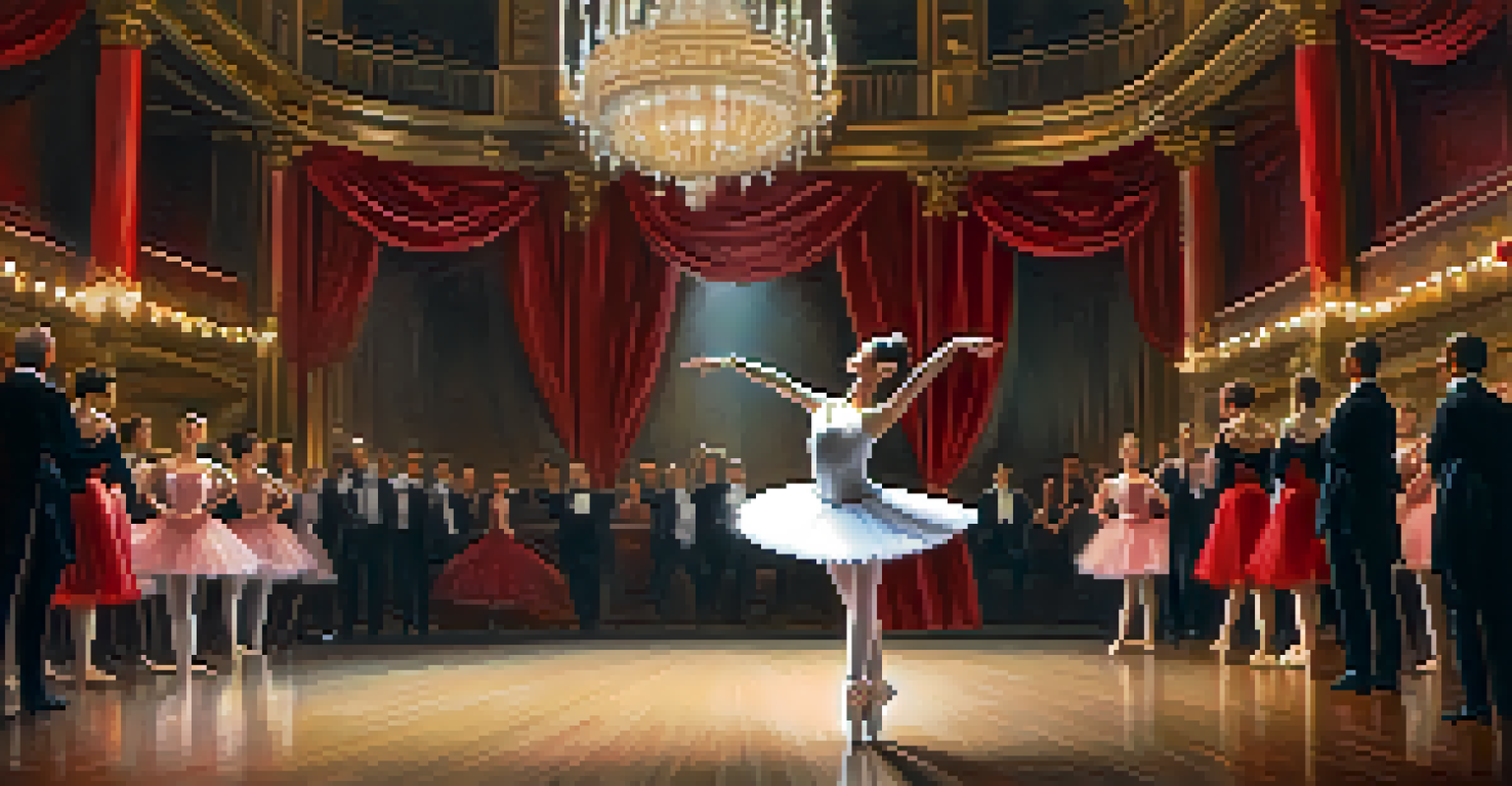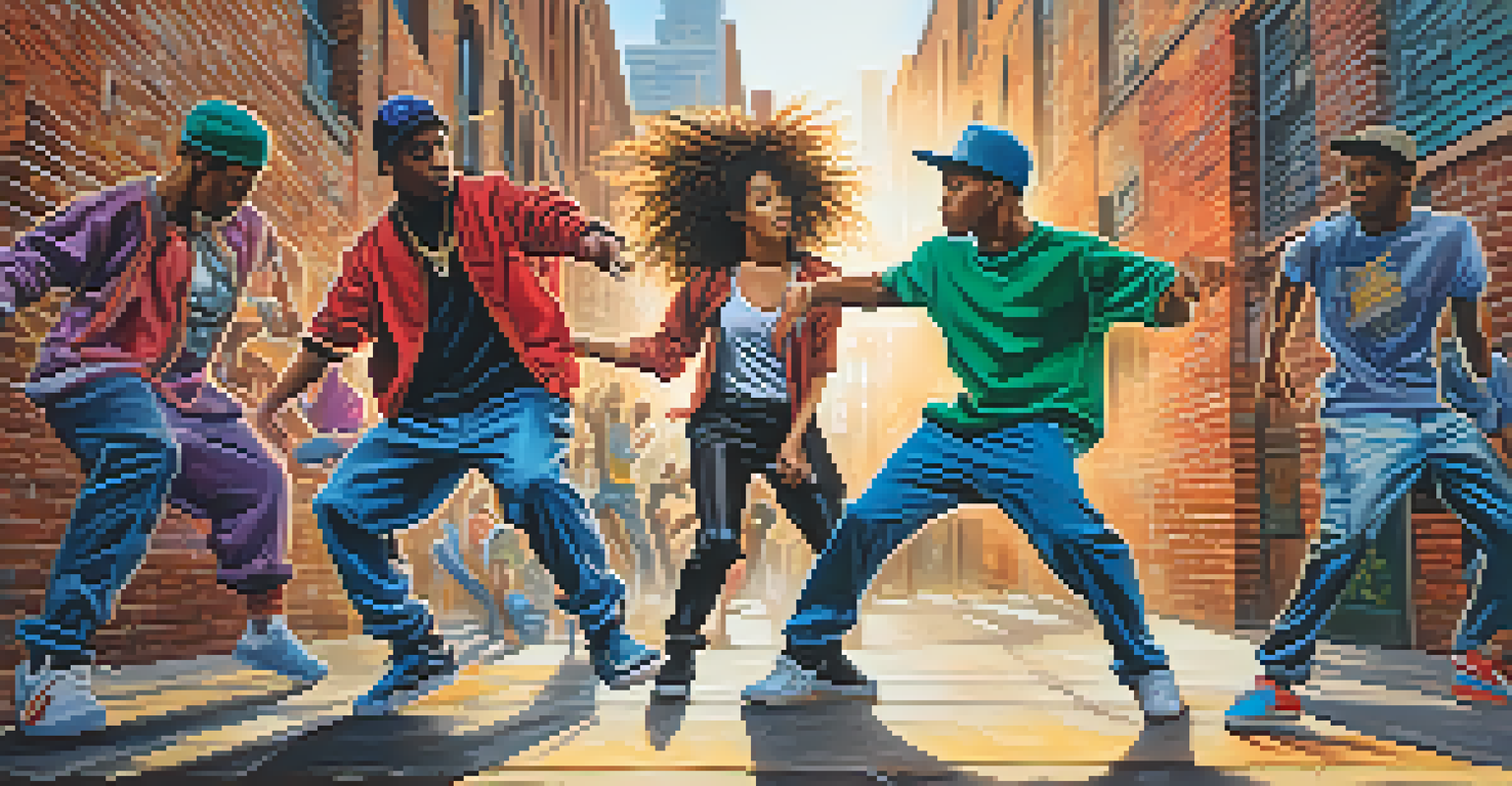The Evolution of Dance Styles and Historical Context

The Roots of Dance: Ancient Beginnings and Rituals
Dance has been an integral part of human culture since ancient times, often used in rituals and celebrations. For early civilizations, dance served as a means of storytelling, expressing spiritual beliefs, and marking significant life events. For example, ancient Egyptians incorporated dance into their religious ceremonies, believing it connected them with the divine.
Dance is the hidden language of the soul.
As societies evolved, so did their dance forms, reflecting cultural values and social structures. The Greeks, for instance, embraced dance in their theater, using it to enhance storytelling and convey emotion. This intertwining of dance and narrative showcases how movement became a vital part of cultural expression, transcending mere entertainment.
Furthermore, these early dance practices laid the groundwork for future styles, establishing a tradition of expressing human experiences through movement. The rituals and communal gatherings not only united people but also fostered creativity, leading to diverse dance forms that would emerge in subsequent eras.
The Influence of the Renaissance on Dance Styles
The Renaissance period marked a significant turning point for the arts, including dance. This era celebrated humanism and the beauty of the human form, leading to more structured and elegant dance styles. Court dances, characterized by intricate movements and patterns, became popular among the European aristocracy, emphasizing grace and precision.

During this time, dance was not just a form of entertainment; it was also a symbol of social status. The elaborate ballrooms and formal gatherings allowed dancers to showcase their skills, and choreography became more sophisticated. This shift led to the development of specific dance styles, such as the pavane and galliard, which still influence contemporary ballet.
Dance as Cultural Expression
Dance has historically served as a powerful means of storytelling and cultural identity across various civilizations.
Additionally, the rise of dance manuals during the Renaissance helped codify these styles, ensuring their preservation and teaching. This documentation played a crucial role in the evolution of dance, allowing future generations to learn and adapt these elegant movements while keeping the spirit of the Renaissance alive.
The Birth of Ballet: Formalizing Dance as an Art
Ballet emerged in the late Renaissance as a formalized dance style, blending art, music, and storytelling. Originating in the courts of Italy and France, it quickly gained popularity as a theatrical performance. The first ballet, 'Le Ballet Comique de la Reine,' was performed in 1581, setting the stage for dance as a serious art form.
Dancing is like dreaming with your feet.
With the establishment of ballet academies, the training of dancers became more rigorous, focusing on technique and discipline. This formal education elevated dance to a respected profession, allowing dancers to master complex movements and express emotion through their art. The iconic positions and movements we associate with ballet today were developed during this time.
Moreover, ballet's evolution paved the way for other dance forms, influencing genres like contemporary dance and jazz. The emphasis on storytelling through movement highlighted the power of dance as a means of communication, making it an essential component of theatrical performances.
The Rise of Folk Dance: Community and Culture
Folk dance emerged as a celebration of community and cultural identity, often passed down through generations. These dances reflect the traditions, customs, and stories of specific regions, fostering a sense of belonging among participants. For instance, the Irish jig and the Spanish flamenco both highlight the unique cultural heritage of their respective countries.
Unlike formal dance styles, folk dances are often characterized by their improvisational nature, encouraging participants to express themselves freely. This inclusivity makes folk dance accessible to everyone, regardless of skill level, fostering community spirit and social connection. Events like barn dances and community festivals showcase the joy and unity that these dances bring.
Renaissance's Impact on Dance
The Renaissance era formalized dance, introducing structured styles and elevating it to an art form that reflected social status.
Furthermore, folk dance has played a significant role in preserving cultural history, acting as a living archive of customs and traditions. As societies evolve, these dances adapt, reflecting contemporary issues while maintaining their roots, proving that dance is a dynamic and evolving art form.
The Jazz Age: Dance and the Roaring Twenties
The 1920s, often referred to as the Jazz Age, brought about a vibrant shift in dance styles, fueled by the rise of jazz music. This era celebrated freedom and self-expression, leading to the emergence of popular dance styles like the Charleston and the Lindy Hop. These dances were energetic, improvisational, and perfectly captured the spirit of the time.
The influence of jazz music on dance was profound, as it encouraged dancers to break free from traditional forms. Social dance halls became the epicenter of this cultural revolution, where people from all walks of life came together to celebrate through movement. The infectious rhythms of jazz music encouraged creativity and personal expression, allowing dancers to develop their unique styles.
Moreover, the Jazz Age marked a significant shift in societal norms, with dance becoming a symbol of liberation and rebellion. The exuberance of these dances not only reflected the cultural changes of the time but also paved the way for future dance styles, influencing everything from swing to modern dance.
The Evolution of Hip-Hop: From Street to Stage
Hip-hop dance emerged in the late 20th century as a cultural movement rooted in urban communities. What began as street performances and breakdancing battles has evolved into a global phenomenon, influencing various dance styles and popular culture. This genre of dance reflects the struggles, triumphs, and creativity of a generation, resonating with audiences across the world.
As hip-hop gained popularity, it transitioned from the streets to professional stages, leading to the creation of dance crews and competitions. Styles like locking, popping, and krumping became recognized forms of expression, each with its unique characteristics and cultural significance. The energy and improvisational nature of hip-hop make it a powerful medium for storytelling and self-expression.
Hip-Hop's Global Influence
Emerging from urban communities, hip-hop dance has transformed into a global phenomenon that emphasizes self-expression and cultural storytelling.
Furthermore, hip-hop's influence extends beyond dance, impacting music, fashion, and art. The genre's ability to adapt and evolve keeps it relevant, ensuring that it continues to inspire new generations of dancers. Hip-hop serves as a testament to the power of dance as a transformative force in society, bridging gaps and fostering connections.
Contemporary Dance: Blending Styles and Breaking Boundaries
Contemporary dance emerged in the mid-20th century as a response to the rigidity of classical ballet and traditional forms. This genre embraces a fusion of various dance styles, allowing for creativity and innovation. Contemporary dancers often explore themes of identity, emotion, and social issues through their movement, making it a deeply expressive art form.
The beauty of contemporary dance lies in its versatility, drawing inspiration from ballet, jazz, hip-hop, and even folk dance. Choreographers like Martha Graham and Pina Bausch pushed the boundaries of movement, encouraging dancers to embody raw emotions and explore human experiences. This emphasis on individuality fosters a unique and personal connection to the art.

Additionally, contemporary dance has become a platform for collaboration across disciplines, merging dance with theater, visual arts, and technology. This blending of styles and ideas not only enriches the art form but also challenges audiences to engage with dance in new and exciting ways. As the dance landscape continues to evolve, contemporary dance remains at the forefront of innovation and expression.